Historic Asset Management Project (HAMP)
The Historic Asset Management Project (HAMP) manages the repair and maintenance of over 500 non-operational historic assets in council ownership.
We have a duty of care to make sure structures in our ownership are safe, but also a duty to protect, maintain and safeguard historic assets under built heritage legislation, for future generations to enjoy. HAMP brings together these 2 important statutory obligations.
Historic assets are part of Aberdeenshire’s heritage, its history and its people. They provide a tangible link to the past and encourage visitors to the region. Many of these assets are listed buildings, historic graveyards and churches, stone circles, Pictish carved stones, war memorials, castles, historic monuments, fountains, towers, pill boxes, commemorative structures and bridges.
A full list of HAMP assets (PDF 217KB) has been made from various data sources. This list can change at any time, as when new information comes to light assets are added, and some are removed when they are found not to be in council ownership.
View completed works:
- St Fergus Old Churchyard Mort House
- St Carol's Church, Ruthven
- Inverbervie Old Church
- Kennethmont Old Churchyard
- Alex Gordon Tomb, Rhynie
- Hatton of Fintray Old Church
- Catterline War Memorial
- Auchterless Old Parish Church, Auchterless
- Kincardine O’ Neil Auld Kirk
- Biggar Fountain, Banff
- New Pitsligo War Memorial
- Inverbervie Market Cross
- Duff House - Mausoleum, Fife Gates and Ice House
- Skene Keith Memorial, Keithhall Graveyard
- Tarland Old Parish Church
- Old Maryculter Churchyard
- Banchory Watch Tower
For more information on the project you can email hamp@aberdeenshire.gov.uk and follow us on Instagram.
St Fergus Old Churchyard Mort House
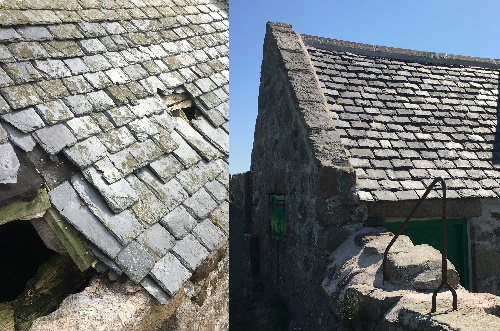
The Mort House was built originally to store dead bodies in before burial at the churchyard. The building is Category B listed, along with the churchyard and boundary walls. A small part of the roof had collapsed with missing slates allowing water to get inside the building. The original door had been lost many years ago and has since been blocked up.
The repair carried out allowed the opportunity to fit a new timber door, repair the roof and two sections of unstable boundary wall, bringing the building back into use as equipment store for the Council’s cemetery workers.
St Carol's Church, Ruthven

St Carol’s Church at Ruthven dates from medieval times with a 17th century bellcote. The church fell into ruin in 1685. All that remains now is the west gable end, which houses the bellcote and bell.
A survey of the structure indicated that the bellcote was showing signs of fatigue with missing areas of pointing, which increased the risk of stonework falling off the building and causing injury to visitors in the churchyard. The structure was scaffolded in Spring 2019 allowing access to the bellcote which was fully repaired.
The original bell has not been moved from its original place and has been secured. The wall heads were repointed to aid water runoff.
Inverbervie Old Church

Inverbervie Old Church is a Category B listed structure, which was covered in ivy. The additional weight the ivy was applying to the gable end of the church was causing concern. Heavy snow or wind would have the potential to bring down the stonework that the ivy was clinging to.
In November 2018 a team of steeplejacks removed the bulk of the ivy, followed by a stonemason repairing the wall heads of the church in February 2019.
Kennethmont Old Churchyard

The Old Churchyard of Kennethmont can be found on the edge of the Leith Hall Estate, neighbouring the main Aberdeen to Inverness train line. It contains the Leith-Hays family mausoleum, as well as the remains of a medieval church surrounded by a stone rubble boundary wall. The entire churchyard is Category B listed.
Sections of the old church and boundary wall had collapsed and the main entrance gates and gate piers were loose.
Allan Smith Stonemasonry undertook repairs in March 2019 to remove ivy, repair the entrance piers and consolidate areas of boundary wall. During the works a lintel dated 1692 was uncovered.
Alex Gordon Tomb, Rhynie
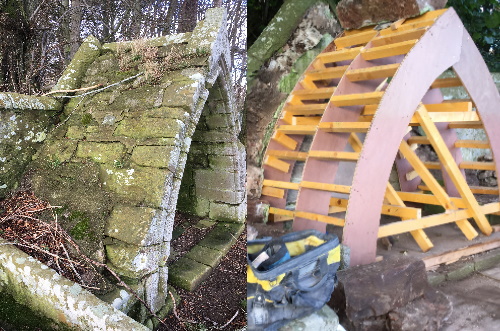
The Alex Gordon Tomb is sited up against the west wall of the Rhynie Old Churchyard and is Category B listed along with the adjacent stone coffin. The tomb dates to 1668, but exhibits older elements of stonework. The tomb is an arch, which at some point in the past had been repaired using a hard cement. The cement was failing and was breaking away from the sandstone, leading to concern over the structural stability of the arched tomb.
Timber centring was placed inside the arch to allow the arch to be taken down and rebuilt using lime mortar with the joints repacked and stones rebedded in September 2019 by stonemasons Masonry & Lime.
Hatton of Fintray Old Church

The Category B listed Hatton of Fintray Old Church was covered in ivy, with people often mistaking it for a large tree within the churchyard. The ivy was removed in November 2019, uncovering the original bellcote on top of the west gable.
It is difficult to assess the condition of the structure, but ivy can add considerable weight to a structure and has the potential to pull the structure down due to high winds or snow fall.
Removing the ivy and repairing the stonework, including putting in a new lintel above the doorway has secured the structure for the foreseeable future for churchyard visitors and workers.
Catterline War Memorial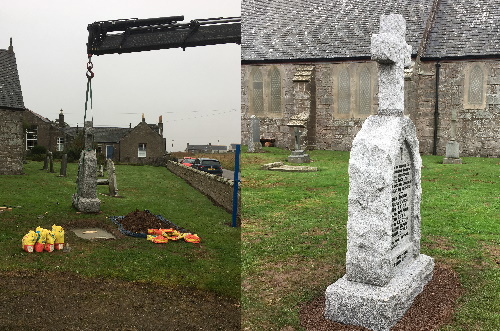
The War Memorial situated within the grounds of Catterline Episcopal Church was leaning raising concern over its stability and the condition of the foundation. The War Memorial was lifted out of position whilst the foundations were excavated. The memorial had been placed on a shallow brick foundation but over time, given the soft soil and ground movement associated with churchyard the memorial had moved.
A new foundation was dug and filled by Fraser Memorials, under the supervision of Alder Archaeology.
Auchterless Old Parish Church, Auchterless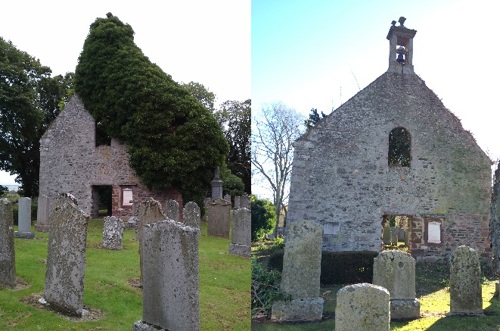
The Old Parish Church, Auchterless, is category B listed and dates from 1780. The gable and 2 rear sections of wall have been covered in extensive ivy growth. We appointed Northern Steeplejacks to remove the ivy in January 2017.
There was concern that the ivy could detach from the building and bring down the stonework with it. The roots of the ivy were also making parts of the structure loose. The removal of the ivy uncovered the bellcote and bell dated 1644.
It also uncovered other structural problems with the bellcote like loose and cracked finials. Watch video of Bellcote inspection by Northern Steeplejacks, which shows what was found once the ivy was removed.
Further work was carried out by Harper and Allan Stonemasonry and involved the repair of the bellcote and gable ends. Small areas of stone were replaced on a like for like basis where it couldn’t be salvaged.
Kincardine O’ Neil Auld Kirk
Kincardine O’Neil Auld Kirk is a 16th century scheduled monument and a prominent landmark within the village of Kincardine O’ Neil. Surveys undertaken by HAMP highlighted that the cement pointing, was failing in a number of areas, resulting in loose masonry and voids in the walls.
Laings Traditional Masonry Group carried out a scheme of repair works over the summer of 2017. All of the cement pointing was removed with hand tools, and they replaced it with an appropriate lime mortar. However, the walls of the kirk had been washed out over many years.
Rough capping was introduced to the wall heads, to encourage rainwater to run away from the building rather pooling and deteriorating the mortar as it had previously. The tops of the buttresses were also reinforced. This significant repairs project has ensured the continued survival of the kirk for many years to come.
Biggar Fountain, Banff
The Biggar Fountain, Low Street, Banff is a category B listing and dates from 1878. Over a number of years the fountain had suffered degradation from natural elements. This resulted in detailing being lost and areas where mortar was missing allowing rainwater to enter the stonework as cracks were beginning to appear.
Works were carried out by Harper and Allan Stonemasonry to replace all the mortar joints with suitable materials for the type of stone. A new piece of stonework was carved to replicate that of an area which had been cracked. The whole fountain was cleaned using water and a brush to remove all the biological growth from it.
New Pitsligo War Memorial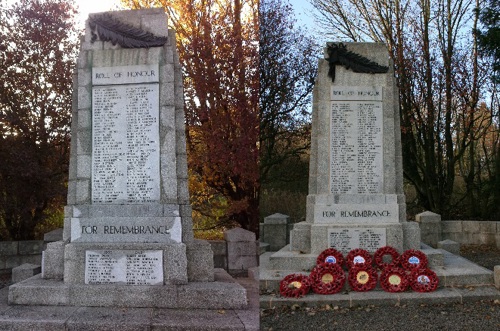
The New Pitsligo War Memorial is a granite blockwork structure which in the past has had repairs carried out in cement to the mortar. This was causing water to be trapped within the memorial and causing the stonework to be very wet. The dampness was then causing algae and moss growth and the bronze feather, which was staining the stonework.
Works were carried out by Garry Laing, Stonecraft to remove all the cement from the monument and replace it with a lime based alternative which will allow moisture to evaporate from the structure. The memorial was also cleaned with water and a brush to remove the staining.
Inverbervie Market Cross 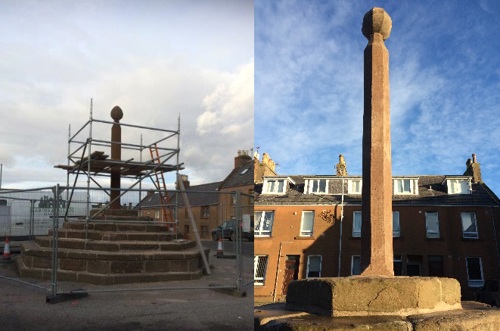
Inverbervie Market Cross is a category B listed structure and dates from 1737. Previous repairs had seen the Market Cross covered in a cement based render which was causing the soft sandstone to deteriorate underneath. The render was also cracked and failing in places. Vegetation growth had occurred in the joints of the steps and rainwater was pooling in areas.
Works were carried out by Harper and Allan Stonemasonry to remove the cement based render and replace with a lime based alternative that would protect the sandstone rather than cause further deterioration. The joints of the steps were raked out and replaced with lime and indents were inserted to the steps in the worst areas to encourage run off of water.
Duff House - Mausoleum, Fife Gates and Ice House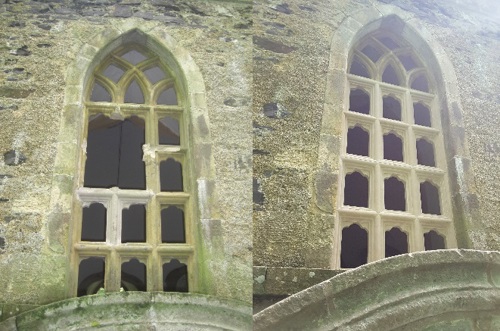
The Duff House Mausoleum is a category A listed building, situated within the policies of Duff House. The Mausoleum had been subject to vandalism where a tracery window at the rear had been broken. The gate was removed and taken away to the contractor’s workshop where it was blasted, refurbished and repainted. The tomb was repointed in lime, with indents attached where the stone had deteriorated. The tomb was then cleaned using water to remove the staining.
The Fife Gates are category B listed. The gates were removed and taken away to as specialist forge workshop in Midlothian where they were blasted to remove the rust and original paint, repaired with new inserts of grey iron and repainted. They were then returned to site and reattached to the gate piers.
Skene Keith Memorial, Keithhall Graveyard
Monkeigie Burial Ground, also known as Keithhall Old Parish Church, is set within the policies of Keith Hall, Inverurie. It is now a closed graveyard within a secluded woodland. The memorial of Reverend Dr George Skene Keith is built within the boundary wall towering significantly higher than the wall and gravestones around it. The monument was in a poor state of repair with a large amount of the granite blockwork backing having had fallen away, leaving the memorial in a precarious position.
Repair works were carried out by Allan Smith Stonemasonry to reinforce the memorial by rebuilding the granite backing and by securing any loose stonework and using a lime based mortar.
Tarland Old Parish Church
Tarland Old Parish Church is a category B listed building dating from 1762. Surveys highlighted that the bellcote was in a fragile condition. There was a number of open joints and movement being caused by vegetation growth and a loss of mortar. The metal work for a bell had become corroded and had expanded, causing the stonework to burst and crack. The bellcote was unstable and needed to be removed.
The bellcote was carefully taken down by Urquhart Stonemasonry, with each stone being numbered and recorded. During its removal, many layers of the granite disintegrated and are unsalvageable. The remains of the bellcote are currently in storage in the Mintlaw Materials Store, although the stones are all in a very poor condition.
Gordon Memorial, Maryculter Churchyard
Maryculter Old Parish Kirkyard is a scheduled monument which encompasses the low level chapel walls, the burial ground and the enclosing walls. A chapel has existed on this site since 1287, becoming disused in 1782 with the erection of the new parish church.
The monument was suffering from severe deterioration or blockwork in certain locations and a lack of overall stability. There were areas where significant movement of the blockwork was noted along with noticeable bulging of the rear elevation. There was evidence of ivy growth on the monument in the past, which had the effect of pushing the blockwork outwards.
Allan Smith Stonemasonry carried out works to stabilise and repair the monument. All granite blocks were recorded as they were taken down to a stable course level, the monument was rebuilt block by block and all joints repointed with a suitable lime based mortar. Loosed blocks were reattached. The cross on the top of the monument was taken down and rebedded with lime mortar and fixed with a stainless steel dowel. The memorial plaques were cleaned and consolidated.
Banchory Watch Tower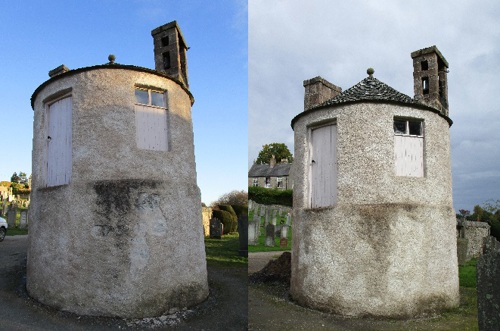
The Watch Tower situated within the Old Churchyard at Banchory is a category B listed structure. It was built in 1829 to protect the graveyard from grave robbers. The tower is a 2-storey structure with a conical roof and contains a bell turret with bell.
HAMP commissioned Urquhart Masonry to carry out some minor repairs to the structure. Parts of an older harl were beginning to detach from the building and there were a number of slates missing off the roof, leading to minor water ingress into the upper floor of the tower.
